As the Covid-19 crisis unfurls, turmoil's in domestic food supply chains, shocks in food production and loss of incomes and remittances, are creating strong tensions and food insecurity. Due to higher retail prices and reduced incomes, households are in need of cutting down on the quantity and quality of food consumption. The U.N. World Food Programme has cautioned that an extraneous 130 million people could face acute food insecurity by the end of 2020, on top of the 135 million people who were already acutely food insecure prior to Covid-19. Food producers are also facing large losses on perishable and nutritious food because of cheaper stapled consumption patterns and farmers' stipulation to consume seeds as food today over planting seeds for tomorrow.
Despite having the food to feed 1.5 times the global population, nine million people die out of hunger or hunger-related disease every year which is more than the combined deaths caused by malaria and tuberculosis. The State of Food Security and Nutrition in the World, a flagship report by Food and Agriculture Organization (FAO), ameliorated that the number of people affected by hunger and malnutrition continues to surge from 2014.
By the same token, 687.8 million people of the world are undernourished while another 2 billion are suffering from moderate and severe levels of food insecurity. Meanwhile, stringent lockdown policies to curb the proliferation of Covid-19 stalemated all kinds of economic activities and disrupted the trade and supply chain which reduced job opportunities and income all over the world.
In this circumstance, Covid-19 fuels hunger and poverty in lower-middle-income countries like Bangladesh. Accompanying economic growth of 7 per cent it has made consequential headway in poverty diminution over the last two decades. Thereupon, poverty rate dropped to 23.2 per cent in 2016 from 48.9 per cent in 2000 (Bangladesh Bureau of Statistics, 2018). This growth facilitates to eradicate hunger from the country through the turn-down of severe food insecurity to 10.6 per cent in 2018. But lockdown measures dented the progress severely. According to a study conducted by Bangladesh Institute of Development Studies (BIDS), 13 per cent of people lost their jobs and 25.5 million new people joined the extreme poverty club. On the other side, South Asian Network on Economic Modeling (SANEM), a think tank, projected that the poverty rate may escalate to 40.9 per cent, pushing 16 million people below the poverty line.
Many small income earners, SME owners, daily labourers, and many more workers from different informal sectors reported zero income throughout the entire time of lockdown. Around 400,000 migrant workers from different countries had to return as income fell sharply due to the global crisis. As a result, a legion of people, who barely had enough food before Covid-19, now undergoes either moderate or severe food insecurity while some of them are facing the cruelty of not having anything to eat. A nationwide survey conducted among 2675 low-income people of the country by BRAC depicts that 14 per cent of people do not have any reserve food while the other 29 per cent have reserve for only 1 to 3 days.
Among the many dimensions of food security, food availability is the one Bangladesh has been doing good at. Undeterred by cyclone 'Amphan' and shortage of labour, the country had a good Boro harvest. However, production in other agricultural sectors i.e., poultry and fisheries have plummeted precipitously owing to disruption in the supply chain. Nevertheless, experts suggest that the production of the foods might be adequate while access to food is the major challenge. Survey data among low-income people exhibit that 47 per cent of the people favoured food support while only 20 per cent of people preferred cash hinting that people are highly vulnerable to hunger. Marginal people such as daily labourers, rickshaw pullers usually do not have any savings.
The government has taken many steps to stimulate the economy through safeguarding the poor populace. Ministry of Finance (MoF) expanded the existing transfer programme to benefit the poor and announced BDT 50 billion for the exporting industries which will redeem the jobs of hundreds. A spare 21.3 billion has been pledged to be disbursed under a housing scheme for the homeless people. Moreover, the government promulgated Tk 7.6 billion for the destitute people who lost their jobs due to Covid-19. Other measures, i.e., food and necessary stuff diffusion, cash transfer etc. have also been implemented by the government. However, a large number of poverty-stricken people, reportedly, did not pick up any form of support either due to mismanagement or lack of information.
Repercussion of Covid-19 on short- and long-term food security is a difficult task to predict, some risk factors can be bumped and lessons from prior pandemics (e.g. Ebola virus disease (EVD) in West Africa in 2014) or global crises (e.g. food prices crisis of 2008) tell that effects on food security could be widespread.
As a developing country, shortage of food has always been a challenge but this time the situation due to the Covid-19 pandemic has made it more acute. To overcome these, policy makers should introduce subsidy based transportation systems for agriculture to make the supply chain alive. In the long run, to keep the food supply stable, some policies have to be put forward to cut the agricultural production cost and support the farmers to deal with the aftermath of the pandemic.
The complexity of the crisis and the context-specific nature of its impacts call for an appropriate policy for combating the issue of food security as a fallout of Covid-19.
Mir Ashrafun Nahar is Research Associate, South Asian Network on Economic Modeling (SANEM).


